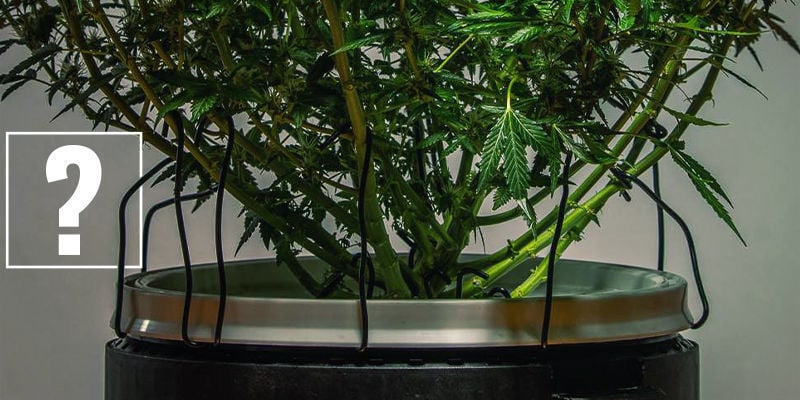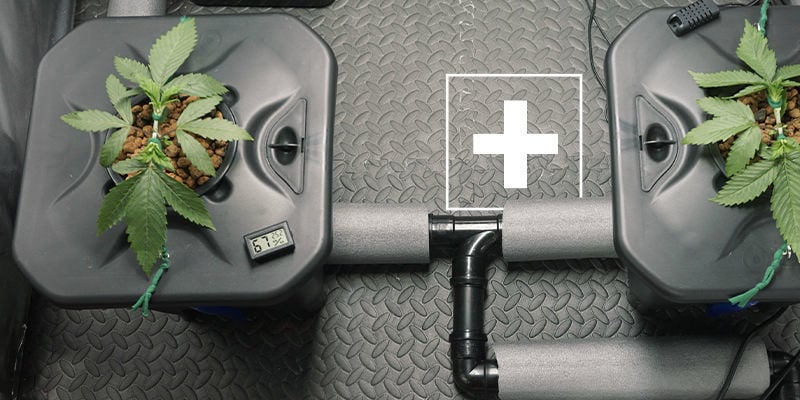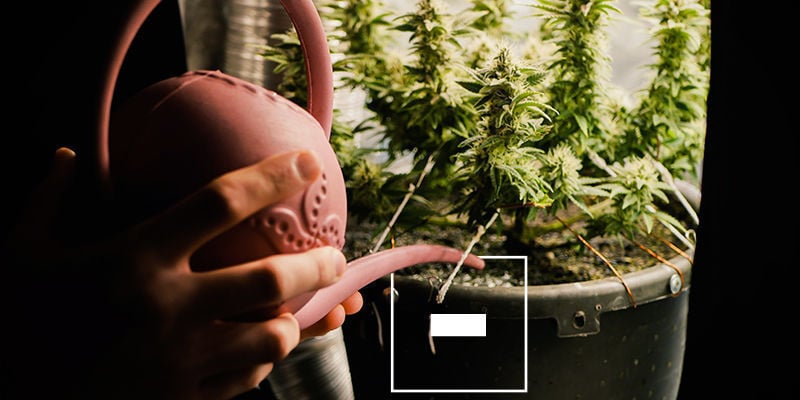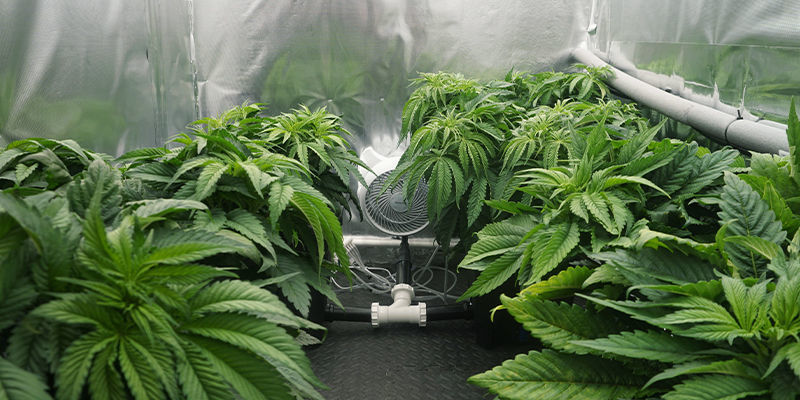
Recirculating Vs. Drain-To-Waste
Despite the many diverse cannabis growing techniques out there, there are actually only two major principles for watering your plants: recirculating and drain-to-waste. Find out the tenets of each method, and see which one is ideal for your next grow.
There are dozens of different cannabis growing principles, hundreds of unique techniques, and maybe even thousands of diverse growing systems. Each is designed to try and solve a problem, make your life simpler, or just increase the bang for your buck.
When it comes to watering your plants, out of all existing combinations and variations, we can boil them down to two principles. Each has its benefits and drawbacks. Plus, one grower’s benefit is another grower’s drawback, depending on the circumstances.
There are only two ways in which to water your plants. Either you use a recirculating system, or a drain-to-waste approach.
WHAT DO THESE TERMS MEAN?

Simply put, drain-to-waste is where you water your plants to a point where a recommended 15-20% by volume starts running-off, escaping the growing medium. This runoff water is discarded entirely.
In a recirculating environment, the runoff is collected and used to feed other plants. Seems pretty simple, but let's remember plants take-in nutrients as they are fed, as well as excrete unwanted minerals and organic matter.
There are numerous advantages and disadvantages to both methods, and only your experience and lifestyle will dictate which is best. Speak to any experienced grower and they will surely tell you how many different systems and methods they have experimented with over time.
Recirculating feeding is not a synonym of hydroponics. Nor is drain-to-waste purely organic. In fact, aquaponics is the epitome of an organic, recirculating hydro setup. Some of the most crop-intensive, technologically advanced hydroponic operations today use drain-to-waste solely - like fast-finishing legumes, microgreens, or intensive grazing forage production.
The primary factors to consider with each method are growing environment, and how well the species is able to cope with the pros and cons of each.
WHICH ONE IS BETTER?
The best entity to answer this question would be Mother Nature. But, if you have ever seen an isolated pond without a water afflux or efflux, yet still flourishing with life - that is technically a natural recirculating setup.
There is no best option, just different methods to suit the species’ needs, the location, and the grower’s objectives and aptitudes.
Cannabis is a magical plant. One of its wonders is how fiercely it can adapt to extreme environments and conditions. It is quite resistant to both drought and waterlogging, and is resilient against bugs and pathogens. This positions weed as a perfect candidate to be a super performer with either watering system. Cannabis surely got the nickname “weed” for some reason, right?
WHAT ARE THE PROS?

The traditional method surely is drain-to-waste. That is what most people think of when talking about watering plants or field farming. But it also has its place in high-tech greenhouses.
You water your plants until excess comes out, ensuring you drenched the soil completely for a uniform feed to the roots. The feeding solution is made fresh before application, and if using chemical fertilisers, drain-to-waste eliminates any salt buildup in the medium. Each watering will function as a sort of mini-flush.
With this technique, nutrients are fresh and the water is well-oxygenated. You can use organic fertilisers easily, as you generally do not prepare a feeding reservoir for it to sit idle for a week or two. You are able to prepare a feed for all your plants, or if needed, alter the NPK and micronutrient profile for individual plants, be it for experimentation or to solve a deficiency.
In recirculating systems, you cannot use organic nutrients for growing weed. It is just a recipe for disaster. Theoretically possible, but a pathogenic nightmare. Unfortunately, aquaponics does not perform enough to fatten-up those buds.
With recirculating systems, you make up one feed for the entire crop in a dedicated reservoir. The larger water volume will secure a more stable pH and chemical composition so that you can run a very large number of plants at the same time. You save 15-20% in water and nutrient costs if all runs smoothly. These systems generally require much less labor-intensive daily maintenance. In fact, if there are no signs of trouble and the reservoir is stable, it is pretty much a hands-off operation requiring minimal maintenance.
WHAT ARE THE CONS?

With drain-to-waste, either you are feeding by hand or using an automated feeding system. If the latter, you are quite limited to the number of plants you can run with one reservoir. The reason is, each plant will require its own feed line, and the longer they run, the efficiency degrades, exponentially rendering you very uneven waterings.
15-20% added cost could really drive accounting numbers through the roof if yields do not accommodate for it. In some jurisdictions, it is illegal to dump fertiliser-charged water into the sewage system and requires a dedicated water processing unit or contracted disposal. If using organic nutrients, obsessive daily checks should be made to ensure there are no clogs in the pipes. Just a few clogs in one given day can be a serious ordeal.
With recirculating feeding, you are unable to tailor the feed for any given plant; the only solution to this is to isolate it from the group. Another major potential hazard is if one plant gets sick, disease will quickly spread to the whole group way before the first signals start popping up.
As plants feed, nutrient levels become unbalanced, which requires dedicated laboratory equipment and expertise to determine the constitution and remedial dosage to add back to ensure optimal NPK and micronutrient values. In the long-run, recirculation will be more cost-efficient than the stated 15-20% loss, but the overhead in laboratory gear may deter most.
SHOULD I CHOOSE RECIRCULATING OR DRAIN-TO-WASTE?
If you are reading this, chances are you are better off with drain-to-waste. Recirculating setups require some expertise in a few areas where drain-to-waste is a perfect teacher.
From learning to read plants and understanding deficiencies, to dialing-in optimum feed levels for a given strain and managing several plants at once, our recommendation is to smoothen the learning curve in your quest to become a grandmaster grower.
Once you reach a level where you know a specific strain inside and out, have a good clone line and a grow-op that is running smooth as silk, then we advise stepping up your game into recirculating.
FINAL THOUGHTS

If you manage to do it right, you will love the extra time off and the added 15-20% in savings that recirculating waterings provide. On the contrary, if something goes wrong, it goes wrong very fast. In this regard, drain-to-waste is far more forgiving.
Modern performance hydroponics have found that vegetative species, which usually have very short life cycles, do exceptionally well in recirculating setups. The speed of harvest cycles and operational convenience of recirculation is definitely a plus.
Fruiting species like tomatoes and cannabis also do exceptionally well in recirculating scenarios, but the added savings are initially diluted in analysis equipment and personnel. The truth is, in the long-run (and on paper), recirculating does seem like the better solution.
In practical terms, the risks mays outweigh the potential benefits. At the same time, medium-scale cannabis grow-ops generally find R-DWC (recirculating deep water culture) to be the optimum equilibrium between workload, risk, and benefit. So to conclude - is it worth your trouble? Only you can answer this question.
-
 4 min
19 May 2022
Top 10 High Yielding Feminized Cannabis Strains
Just by picking the right strain, yields can be improved dramatically. All the research, preparation, and cannabis care cannot outweigh the importance of choosing strains with proven genetics....
4 min
19 May 2022
Top 10 High Yielding Feminized Cannabis Strains
Just by picking the right strain, yields can be improved dramatically. All the research, preparation, and cannabis care cannot outweigh the importance of choosing strains with proven genetics....
-
 7 min
1 February 2021
Perpetual Harvesting: How To Crop Cannabis All Year Long
If you're like most cannabis growers, you may think you're limited to just one harvest per year. However, with the right space, tools, and techniques on your side, you can enjoy new buds every few...
7 min
1 February 2021
Perpetual Harvesting: How To Crop Cannabis All Year Long
If you're like most cannabis growers, you may think you're limited to just one harvest per year. However, with the right space, tools, and techniques on your side, you can enjoy new buds every few...
-
 6 min
6 June 2018
How To Grow Your First Cannabis Plant In 10 Steps
For some, cannabis cultivation is a hobby. Many growers want to become marijuana self-sufficient. Others aim to turn pro. Regardless, it all begins with a seed. In this step-by-step guide, we offer...
6 min
6 June 2018
How To Grow Your First Cannabis Plant In 10 Steps
For some, cannabis cultivation is a hobby. Many growers want to become marijuana self-sufficient. Others aim to turn pro. Regardless, it all begins with a seed. In this step-by-step guide, we offer...
-
 4 min
25 April 2018
How To Grow Sticky Beast Automatic Weed
When it comes to growing primo cannabis, there are more ways than one to end up with loads of supreme weed. Check out Top Shelf Grower's experience growing this strain, and learn from one of the best.
4 min
25 April 2018
How To Grow Sticky Beast Automatic Weed
When it comes to growing primo cannabis, there are more ways than one to end up with loads of supreme weed. Check out Top Shelf Grower's experience growing this strain, and learn from one of the best.
-
 4 min
10 April 2018
5 Ways To Increase Cannabis Yields
Increasing cannabis yields is of paramount importantance to all growers. With our 5 simple methods even tiny gardens of just one or two cannabis plants can produce a heavy harvest.
4 min
10 April 2018
5 Ways To Increase Cannabis Yields
Increasing cannabis yields is of paramount importantance to all growers. With our 5 simple methods even tiny gardens of just one or two cannabis plants can produce a heavy harvest.
-
 5 min
16 February 2018
How To Eliminate Cannabis Odour
Cannabis exudes pungent aromas, which sometimes need to be disguised. Discover the smartest ways to keep your cannabis endeavours low-key.
5 min
16 February 2018
How To Eliminate Cannabis Odour
Cannabis exudes pungent aromas, which sometimes need to be disguised. Discover the smartest ways to keep your cannabis endeavours low-key.













 United States
United States










